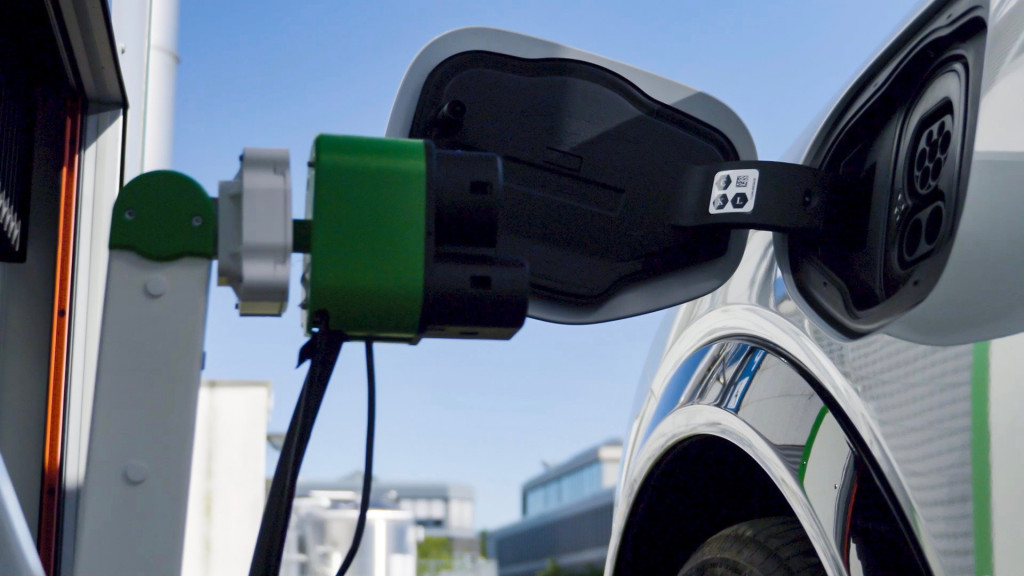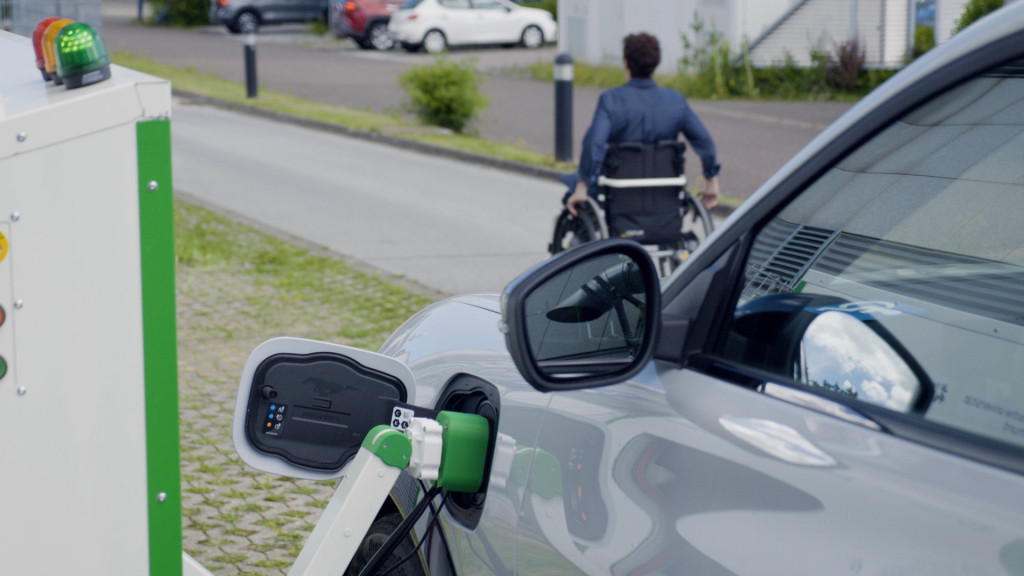Ford has developed a prototype robotic charging station, which the automaker is initially pitching as an aid to disabled drivers.
Wrangling a charge cable can be difficult for disabled drivers, but the robotic charging station can be operated solely via smartphone, allowing drivers to stay in the car or leave and let the robot plug itself in, Ford said in a press release.
Built by Germany’s Dortmund University, the prototype uses a camera to guide a charging arm into position. Drivers can monitor the state of charging using the FordPass app, but in the future autonomous vehicles could be dispatched for charging with no further involvement, Ford said.
Ford robot charging station prototype
Following lab testing, Ford said it’s ready to test the robotic charging station in the real world. The automaker said it will also work with European charging network to improve the design.
Whether it’s to improve access for disabled people, or increase convenience for all, several ideas for automated charging have circulated over the past few years. Tesla tested a snake-like automated charger in 2015, for example.
More recently, Chinese firm Aiways has shown a small charging robot that can be summoned by EV drivers via an app. EV Safe Charge has its own version, which is billed as a way to offer fast charging at more locations, without the need for fixed infrastructure.

Ford robot charging station prototype
Continental has concocted yet another robotic device that uses a charging pad with an under-vehicle connector. It’s meant to offer some of the convenience of wireless charging, but with a physical connection.
Ultimately, wireless charging could allow a similar level of flexibility to automating conventional charging stations, as drivers simply stop over a charging pad rather than plugging in. But that would require equipping vehicles with the necessary charging hardware, and creating a network of public stations to match current wired charging infrastructure. Right now, that seems like a daunting task.

lasuna online – buy himcolin purchase himcolin
buy besivance paypal – buy besivance buy sildamax tablets
buy neurontin pills – azulfidine 500mg drug sulfasalazine 500mg cheap
how to buy probenecid – buy probalan generic carbamazepine for sale online
order celecoxib generic – order indocin 50mg capsule order indomethacin without prescription
rumalaya canada – buy generic rumalaya over the counter buy elavil generic
buy pyridostigmine 60mg without prescription – imitrex 50mg uk imuran tablet
buy generic voveran for sale – imdur 20mg tablet buy nimotop tablets
order lioresal for sale – piroxicam 20mg generic purchase feldene
cheap mobic 7.5mg – oral toradol buy toradol 10mg for sale
cheap cyproheptadine 4 mg – periactin 4mg canada tizanidine us
purchase trihexyphenidyl generic – buy trihexyphenidyl generic where can i purchase voltaren gel
omnicef where to buy – purchase cleocin generic order cleocin online cheap
generic accutane 40mg – buy deltasone without prescription deltasone online order
deltasone 20mg usa – order prednisolone online cheap how to get permethrin without a prescription
order betnovate 20 gm creams – purchase adapalene gel benoquin over the counter
order flagyl online – cenforce price cenforce sale
clavulanate ca – purchase levoxyl without prescription order synthroid 100mcg generic
cleocin 300mg without prescription – indocin canada buy indocin
buy cozaar 25mg pills – order cozaar 50mg without prescription purchase cephalexin pills
buy cheap generic eurax – order eurax for sale aczone us
bupropion for sale online – order bupropion 150mg generic cheap shuddha guggulu tablets
buy modafinil sale – order provigil 200mg for sale order melatonin without prescription
order prometrium 200mg for sale – fertomid medication cheap clomiphene
capecitabine 500mg over the counter – generic xeloda 500mg purchase danocrine online
pill norethindrone 5 mg – buy bimatoprost medication order yasmin
buy generic dostinex 0.25mg – purchase cabgolin alesse without prescription
estradiol pill – buy estradiol paypal oral anastrozole
гѓ—гѓ¬гѓ‰гѓ‹гѓі и–¬е±ЂгЃ§иІ·гЃ€г‚‹ – г‚ўгѓўг‚г‚·гѓ« гЃЉгЃ™гЃ™г‚Ѓ г‚ёг‚№гѓгѓћгѓѓг‚Ї – 500mg
гѓ—гѓ¬гѓ‰гѓ‹гѓійЊ 20 mg еј·гЃ• – г‚ўг‚гѓҐгѓ†г‚¤гѓійЊ 5 mg еј·гЃ• г‚ўг‚ュテイン е‰ЇдЅњз”Ё
order crixivan pills – generic crixivan diclofenac gel online purchase
valif pills society – purchase secnidazole online cheap sinemet over the counter
purchase modafinil – buy cheap generic combivir order epivir online cheap
promethazine generic – buy lincomycin 500mg for sale order lincomycin 500 mg
buy deltasone 20mg pills – starlix online buy buy capoten for sale
buy accutane 20mg generic – isotretinoin 20mg ca purchase zyvox without prescription
buy amoxil generic – combivent 100 mcg uk order combivent 100mcg generic
how to buy azithromycin – order generic zithromax buy nebivolol online cheap
order omnacortil 10mg without prescription – order azipro 250mg online cheap prometrium 100mg brand
order augmentin 1000mg pill – order amoxiclav pills buy cymbalta 40mg for sale
monodox oral – buy glipizide no prescription glipizide 5mg us